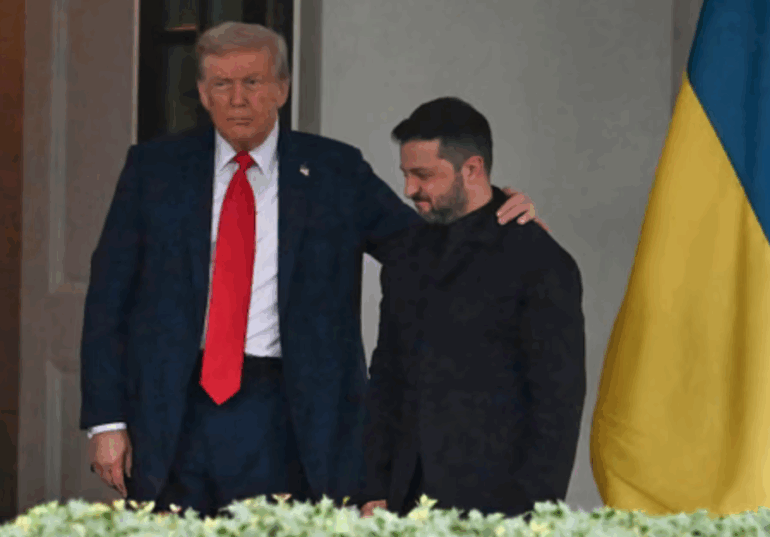On Friday, October 17, 2025, Ukrainian President Volodymyr Zelenskyy will meet with U.S. President Donald Trump at the White House to discuss critical support for Ukraine, particularly the potential supply of Tomahawk cruise missiles. This meeting follows Trump’s announcement of a “very productive” call with Russian President Vladimir Putin, where they agreed to hold a summit in Budapest to address the ongoing Russia-Ukraine conflict, now in its fourth year.
Tomahawk Missiles: A Game-Changer for Ukraine?
The focal point of Zelenskyy’s visit is the possible transfer of U.S. Tomahawk cruise missiles to Ukraine. These long-range weapons, capable of striking targets up to 1,500 miles away, could allow Ukraine to hit deep into Russian territory, including Moscow. Trump has hinted at providing these missiles in recent weeks, which would mark a significant escalation in U.S. support for Ukraine. However, during his call with Putin, Trump expressed doubts about depleting U.S. stockpiles, stating, “We need them too, so I don’t know what we can do about that.”
Tomahawks, first used in combat in 1991, are typically launched from ships or submarines, which Ukraine lacks. A newer land-based variant, the Typhon system, could be more suitable, but the U.S. has limited launchers, with only two known Typhon systems and a recently demonstrated X-Mav launcher. Experts like Rob Lee from the Foreign Policy Research Institute note that the U.S. has a limited supply of Tomahawks, estimated at 20 to 50 missiles, making large-scale deployment challenging. Additionally, the Typhon system requires specialized vehicles and command posts, which are still in production.
Trump’s Diplomatic Balancing Act
Trump’s recent call with Putin and his planned Budapest summit signal his intent to broker peace in Ukraine, building on his recent success in negotiating a Gaza peace deal. However, his history of setting deadlines for Russia, only to soften his stance after talks with Putin, raises questions about his commitment to arming Ukraine. For instance, in July, Trump threatened sweeping sanctions if Putin did not agree to a ceasefire but did not follow through after their August meeting in Alaska, which failed to yield a breakthrough.
Some in Moscow view Trump’s talk of Tomahawks as a negotiating tactic to pressure Putin rather than a genuine plan to supply Ukraine. Vladimir Frolov, a former Russian diplomat, called it a “bluff,” arguing that the limited availability of missiles and launchers makes large-scale deployment impractical. The Kremlin has warned that supplying Tomahawks would escalate the conflict to a “qualitatively new stage,” potentially drawing the U.S. deeper into the war. A former Russian defense official noted that while Tomahawks may not drastically alter the battlefield, their delivery would signal a significant shift in U.S.-Russia relations, potentially eroding Putin’s confidence in Trump as a partner.
Zelenskyy’s Push for Support
Zelenskyy’s visit comes after two “productive” phone calls with Trump over the weekend, a stark contrast to their strained meeting in February when Trump and Vice President JD Vance publicly criticized him. Relations have since improved, with Trump expressing support for Ukraine’s goal to reclaim its territory. Zelenskyy has emphasized the urgency of acquiring advanced weapons, noting that Russia’s recent large-scale attack on Ukraine, involving 28 ballistic missiles and 320 drones, underscores Moscow’s aggressive strategy.
Poland’s Foreign Minister Radek Sikorski highlighted the strategic value of Tomahawks, noting that Russia’s vast size makes it difficult to defend against such long-range weapons. The Institute for the Study of War estimates that 1,900 Russian military targets fall within the missiles’ range. Ukraine has already used U.S.-supplied intelligence and Atacms missiles to strike Russian oil refineries, causing fuel shortages and rising prices in Russia, a strategy that Tomahawks could amplify.
Budapest Summit and Global Reactions
Trump’s planned meeting with Putin in Budapest, supported by Hungarian Prime Minister Viktor Orban, has sparked mixed reactions. Orban, who has criticized the European Union’s pro-war stance, called the summit “great news for peace-loving people.” However, Ukraine’s ambassador to the U.S., Olga Stefanishyna, argued that Russia’s recent attacks expose its lack of interest in peace, urging stronger sanctions and military support.
Trump’s broader diplomatic efforts include pressuring countries like India and China to halt Russian oil purchases, though India’s foreign ministry recently denied claims of a conversation between Trump and Prime Minister Narendra Modi on this issue. These efforts reflect Trump’s strategy to economically isolate Russia while navigating complex negotiations with both Ukraine and Russia.
Conclusion
As Zelenskyy makes his case for Tomahawks at the White House, the world watches Trump’s next move. Will he prioritize arming Ukraine to shift the war’s dynamics, or will his Budapest summit with Putin lead to a diplomatic resolution? The outcome of these talks could redefine the Russia-Ukraine conflict and U.S. foreign policy in the region.
